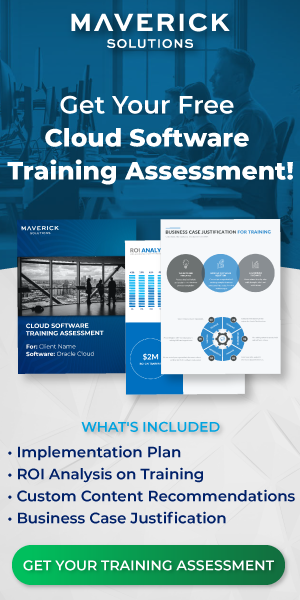Author: Danielle Gentry
Succession Management is an offering within Oracle Human Capital Management (HCM) Cloud that lets you create and manage succession plans in order to make informed decisions about employees who will eventually replace other employees in core positions.
A succession plan identifies candidates for a role or position or to succeed a named incumbent. An incumbent is a worker leaving their current position.
Succession planning is crucial for the long-term success of your company. Without a proper succession plan, your company is at risk for unexpected vacancies, due to illnesses, accidents, natural disasters, or early retirements. Creating a succession plan ensures that your company can react quickly and efficiently to unforeseen changes.
Succession Management offers a way to manage the succession process to ensure a seamless transition. You can use the Oracle Cloud Succession Management business process to decide who is ready to move into a position before it becomes vacant. You can also plan for incumbents, those leaving a position, and candidates, which are the replacements of those incumbents, to make sure the right person fills the job.
The Succession Management business process includes the following steps:
- Create and manage talent pools of selected candidates. A talent pool is a group of workers that are categorized based on their performance, potential, or functional area.
- Conduct a talent review meeting. During this meeting, organization managers can evaluate trends, assess strengths, and address areas of risk for your organization. Adding talent pool members allows you to discuss their potential and rate them accordingly.
- Access talent review notes and tasks.
- Identify the candidate that best suits the job, based on their readiness levels. A worker’s readiness level indicates how soon they could develop the skills needed to fill an open job.
- Manage career development.
- Perform a worker evaluation.
- Create and manage succession plans.
- Manage workforce reputation. Oracle Workforce Reputation Management helps organizations locate talent profiles by using social media networks.
Succession Management and Talent Review Integration
When managing succession plans, you will need to become familiar with Talent Review and Succession Management, which are two functional areas in Oracle HCM Cloud.
The talent review process is made up of at least one talent review meeting and functions to determine your organization’s strengths, trends, and potential risk areas. During the talent review process, you can build succession plans and talent pools and attach workers to them.
You can add candidates in a succession plan to an existing talent pool to manage candidate development. A talent pool’s development goals facilitate the career growth of candidates so that they can successfully perform their current role, or gain the skills needed for the succession plan’s job or position.
Succession Plan Attributes
The following attributes are available to assist you when you are deciding which succession plan candidate is the best fit for a vacant job position:
- Readiness level: This attribute indicates how soon a user could potentially take over the open job. It is not always the case that you have a qualified candidate ready to fill any given role, so you may have to select a candidate that you believe could easily develop the necessary skills required for the role.
A candidate’s readiness level is based on your knowledge of the candidate, as well as how well the candidate’s competencies align with the required skills for the vacant position.
- The readiness levels given to all of a plan’s candidates can help you determine the bench strength for your organization, as well as for the listed job. For instance, if the readiness levels show that you do not currently have a candidate that will be ready to fill the position in the next three years, then you have a poor bench strength and you will need to add additional candidates.
- Interim Successor: This attribute indicates that the candidate is not able to be considered as a prospect for the position, although they can perform the required duties until a successor is selected.
- Candidate Ranking: This attribute indicates a candidate’s order of preference to fill the succession plan’s listed job when it becomes vacant. Candidates can be either be ranked across the whole plan, or within a particular readiness category.
How to Create and Manage Succession Plans
When creating a succession plan, you can choose from the following three available succession plan types:
- Job: Job succession plan types are used to determine candidates for a generic job that exists within several departments, such as a sales representative.
- Incumbent: Incumbent succession plan types are used when your company wishes to replace a specific person.
- Position: Position succession plan types are used to determine candidates for a specific position that is fixed within a department, such as the Senior Vice President for Marketing.
HR specialists, as well as any users with the necessary duty roles, can view, create, and manage succession plans from Oracle Cloud HCM’s Succession Plans work area. Succession plans can also be created from the organization chart or from a talent review meeting.
While your company’s HR specialist will be responsible for completing most of the Succession Management tasks, line managers with the correct security access are also able to view succession plans and candidate information.
Within the Succession Plans work area, you can also perform the following actions:
- Search for and view all your company’s available succession plans.
- Create a new succession plan.
- View the organization chart.
- Select a succession plan and view its plan details, including plan type, plan owner, status, candidates, and incumbents.
- View the number of candidates for a particular succession plan, as well as the strength of the plan according to their number and succession readiness. You can also view matching readiness levels.
- Edit an existing succession plan.
Managers are able to create a succession plan for their direct and indirect reports. An employee’s manager, not the employee themselves, can view the worker’s candidacy for a certain job or position within a succession plan.
Viewing Candidate and Incumbent Information
You can view an incumbent’s information on the Succession Overview page, Succession Planning tab of the Person Spotlight, or the Incumbents section of the succession plan.
You will need to run the Succession Plan Incumbents process in order to view incumbents for existing Job and Position type succession plans. This process should be run whenever there are employee changes that could affect the succession plan, such as an employee being transferred to another department.
You can view a candidate’s status, readiness information, and the date that they were added to the succession plan from a plan’s Candidates section. For internal candidates, you can also view their current title. For users that are candidates in multiple plans, you can view the total number of plans they are candidates for, as well as the number of these plans that are available for you to access.
Private and Public Succession Plans
Succession plans can either be private or public plans. Private succession plans are only accessible by the specified owners.
Public succession plans can be managed by the following users:
- Users that are given the super user role by an administrator. Succession plan super users can view all succession plans.
- Plan owners, which are selected by the user that created or edited the succession plan. Plan owners can access and modify the plan.
- A user with access to the plan’s named or inferred incumbent. An inferred incumbent is any user with the specific job or position for which the plan was created for.
Adding Candidates to the Plan
You can have more than one succession plan owner from varying organizations. This enables you to include candidates in your succession plans that are from different organizations. You can add employees you have access to as candidates, or you can add external candidates.
Succession plan owners can add candidates to plans by either manually searching for and selecting them, or by using the Best Fit analysis. This feature lets the application automatically search for employees whose skills align with the role’s requirements.
There are four available best-fit analysis types, as detailed below:
- Person to Job: Finds a job that best fits a worker based on their person profile, which details the worker’s skills, qualifications, experience, and other career information. This type is used when helping a worker locate jobs that best suit them.
- Person to Person: Finds a worker with skills matching another worker based on their person profile. An example of this type would be if you know there is an employee in your department with the skills necessary for using a new software program, so you use their person profile to match other workers with the same skills.
- Job to Person: Finds a job that best matches another job, based on the job profile. The job profile type can be aligned with either a job or position. Use this type to find jobs to identify areas for training or outplacement.
- Job to Job: Finds a worker that best fits a job based on the job profile. Use this type to locate the most qualified workers for a job opening.
HR specialists, along with employees and managers, can use the Best-Fit feature to compare profiles with the specified match criteria.
Benefits of Succession Management
As previously mentioned, succession management is extremely beneficial for your company. The following list outlines four of the major benefits of using succession plans:
- Succession plans function as another form of company insurance, as they protect your company in the case of unforeseen vacancies.
- Succession plans allow HR to create intentional training, allowing employees to develop the skills necessary to fill key senior roles in case of an opening.
- Succession plans can improve employee morale, reassuring workers that their company sees them as essential parts of their organization, and are willing to assist them develop skills needed to move up in the company.
- Succession plans reduce recruitment costs, by cutting the need for an HR firm to find external candidates for job openings.
You can access detailed walkthroughs on Oracle Succession Management and more with ENGAGE by Maverick, Maverick Solutions’ comprehensive subscription-based training content on Oracle Cloud applications. Offering fully customizable Training as a Service (Taas), Maverick Solutions can provide your organization:
- Training available anytime, anywhere
- Content that’s always current with software updates
- Interactive simulations
- Learning consultation to determine your organization’s training needs
To learn more about our fully customizable training services, speak with one of our training experts today!
The article was written for Oracle release 21B. Due to the nature of Cloud software and updates, this article may no longer be accurate. If you would like access to the most up-to-date version, please reach out to our team to learn more.





